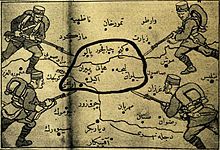
Back ثورة الشيخ سعيد Arabic Şeyx Səid üsyanı Azerbaijani شیخ سید عۆصیانی AZB শেখ সাইদ বিদ্রোহ Bengali/Bangla شۆڕشی شێخ سەعیدی پیران CKB Scheich-Said-Aufstand German Xoverdayışê Şêx Seidi DIQ Κουρδική ανταρσία Greek شورش شیخ سعید Persian Révolte de Cheikh Saïd French
This article may require cleanup to meet Wikipedia's quality standards. The specific problem is: Text contains incorrect grammar that could be translated text. (October 2022) |
| Sheikh Said rebellion | |||||||
|---|---|---|---|---|---|---|---|
| Part of Kurdish rebellions in Turkey | |||||||
 Turkish soldiers encircling Palu, Çapakçur (present-day: Bingöl), Genc (present-day: Kaleköy, Solhan), Piran, Hani, Lice, Ergani, Egil and Silvan, Cumhuriyet Newspaper, 30 March 1925. | |||||||
| |||||||
| Belligerents | |||||||
|
|
| ||||||
| Commanders and leaders | |||||||
|
|
| ||||||
| Strength | |||||||
|
February–March: 25,000 men (fewer than 12,000 are armed troops; the rest are unarmed logistical troops)[1] April: 52,000 men (25,000 are armed troops)[1] | 15,000 men[1] | ||||||
| Casualties and losses | |||||||
| Total: 15,000–20,000 killed[2] | |||||||
The Sheikh Said rebellion (Kurdish: Serhildana Şêx Seîd,[5] Turkish: Şeyh Said İsyanı) was a Kurdish nationalist rebellion in Turkish Kurdistan in 1925 led by Sheikh Said and with support of the Azadî[6] against the newly-founded Turkish Republic.[7] The rebellion was mostly led by Zaza speakers, but also gained support among some of the neighboring Kurmanji-speaking Kurds in the region.[8]
The religious and nationalist background of the Sheikh Said rebellion has been debated by the scholars.[9] The rebellion was described as "the first large-scale nationalist rebellion by the Kurds" by Robert W. Olson.[10]
- ^ a b c d Olson 1989, p. 107.
- ^ The Militant Kurds: A Dual Strategy for Freedom, Vera Eccarius-Kelly, page 86, 2010
- ^ Martin van Bruinessen, "Zaza, Alevi and Dersimi as Deliberately Embraced Ethnic Identities" in '"Aslını İnkar Eden Haramzadedir!" The Debate on the Ethnic Identity of The Kurdish Alevis' in Krisztina Kehl-Bodrogi, Barbara Kellner-Heinkele, Anke Otter-Beaujean, Syncretistic Religious Communities in the Near East: Collected Papers of the International Symposium "Alevism in Turkey and Comparable Sycretistic Religious Communities in the Near East in the Past and Present" Berlin, 14-17 April 1995, BRILL, 1997, ISBN 9789004108615, p. 13.
- ^ Martin van Bruinessen, "Zaza, Alevi and Dersimi as Deliberately Embraced Ethnic Identities" in '"Aslını İnkar Eden Haramzadedir!" The Debate on the Ethnic Identity of The Kurdish Alevis', p. 14.
- ^ Zülküf, Ergün (2015). "Gotara Dijkolonyal û Wêneyê Serdestiya Tirkan Di Kovara Hawarê De" (PDF). Monograf (in Kurdish) (3). Artuklu University: 400–437.
- ^ Olson 1989, p. 42.
- ^ Hassan, Mona (10 January 2017). Longing for the Lost Caliphate: A Transregional History. Princeton University Press. ISBN 978-1-4008-8371-4.
- ^ Mehmed S. Kaya (15 June 2011). The Zaza Kurds of Turkey: A Middle Eastern Minority in a Globalised Society. I.B.Tauris. pp. 64–. ISBN 978-1-84511-875-4.
was led specifically by the Zaza population and received almost full support in the entire Zaza region and some of the neighbouring Kurmanji-dominated regions
- ^ Özoğlu, Hakan (2009). "Exaggerating and exploiting the Sheikh Said Rebellion of 1925 for political gains". New Perspectives on Turkey. 41: 181–210. doi:10.1017/s0896634600005410. ISSN 0896-6346. S2CID 152152964.
- ^ Olson 1989, p. 153.
© MMXXIII Rich X Search. We shall prevail. All rights reserved. Rich X Search